Late Triassic Tectonic Setting in Northeastern Margin of North China Craton: Insight into Sedimentary and Apatite Fission Tracks
Abstract
1. Introduction
2. Geological Setting and Sample Description
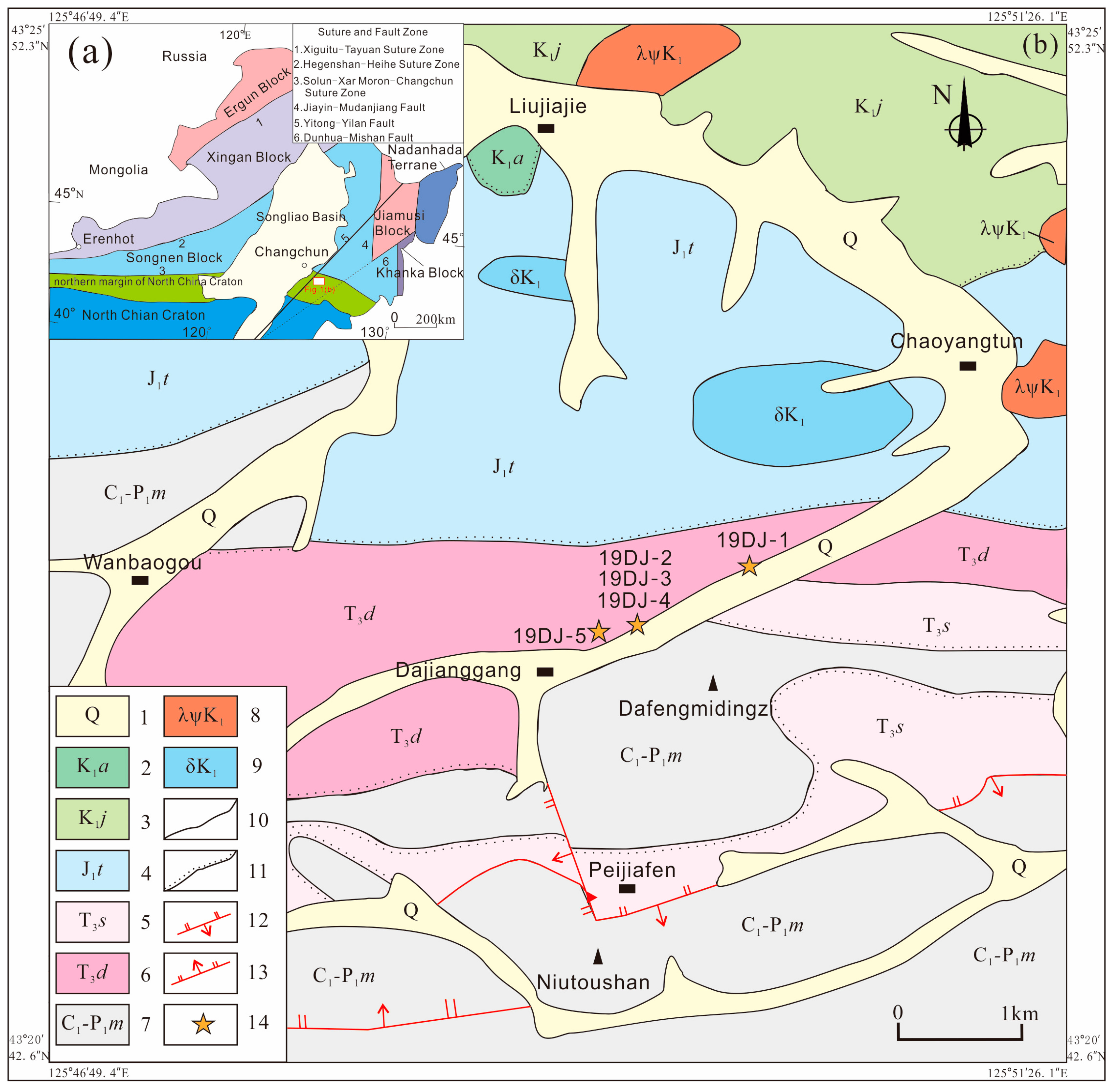
3. Methodology
3.1. Analysis of Geochemical Characteristics
3.2. Zircon U-Pb Isotope Dating
3.3. Apatite Fission Track
4. Petrographic Characteristics and Analysis of Detrital Particle Composition
5. Analysis of Geochemical Characteristics
5.1. Geochemical Characteristics of Major Elements
5.2. Geochemical Characteristics of Trace Elements
6. Analysis of LA-ICP-MS Zircon Dating Results
7. Analysis of Apatite Fission Track Results
8. Discussion
8.1. Provenance and Tectonic Setting Reflected by Clastic Components of Sandstone
8.2. Provenance and Tectonic Setting Reflected by Geochemical Characteristics of Sandstone
8.3. Provenance and Tectonic Setting Reflected by LA-ICP-MS Analysis of Detrital Zircons from Sandstone
8.4. Tectonic Setting and Evolution History Reflected by Apatite Fission Track Results in Sandstone
9. Conclusions
- (1)
- The Dajianggang Formation sandstone in the Shuangyang area is mainly feldspar lithic sandstone, and the lithic type is mainly volcanic lithic. Petrographic studies suggest that the clastic grains are angular, indicating near-source sedimentary characteristics. Dickinson diagram analysis reveals that the sandstone’s main provenance is from island arcs, with some samples showing mixed characteristics from recycled orogenic belts and subduction complex belts.
- (2)
- The geochemical analysis of sandstone samples from the Shuangyang area suggests a continental island arc environment, with felsic rocks dominating the provenance, mixed with active continental margin materials.
- (3)
- The U-Pb chronology of detrital zircon LA-ICP-MS shows that the Dajianggang Formation has a maximum depositional age of 226.8 ± 5 Ma, indicating that it formed in the Carnian of the middle Late Triassic period, at the earliest. The distribution of zircon ages suggests that the main source of the Dajianggang Formation was the Late Triassic magmatic arc of the Changchun–Yanji suture zone, possibly mixed with materials from the northern margin of the North China Craton, in a convergent tectonic setting.
- (4)
- The apatite fission track analysis reveals that the Dajianggang Formation underwent a thermal history that started around 240 Ma and experienced rapid exhumation to the surface since 30 Ma. This implies that the orogenic process in the study area ceased during the Late Triassic period, and the remote effect of Pacific subduction did not impact the study area until 30 Ma.
Supplementary Materials
Author Contributions
Funding
Data Availability Statement
Acknowledgments
Conflicts of Interest
References
- Şengör, A.M.C.; Natal’in, B.A. Paleotectonics of Asia: Fragments of a synthesis. Tecton. Evol. Asia 1996, 1, 486–640. [Google Scholar]
- Li, J.-Y. Permian geodynamic setting of Northeast China and adjacent regions: Closure of the Paleo-Asian Ocean and subduction of the Paleo-Pacific Plate. J. Asian Earth Sci. 2006, 26, 207–224. [Google Scholar] [CrossRef]
- Eizenhöfer, P.R.; Zhao, G.; Zhang, J.; Sun, M. Final closure of the Paleo-Asian Ocean along the Solonker Suture Zone: Constraints from geochronological and geochemical data of Permian volcanic and sedimentary rocks. Tectonics 2014, 33, 441–463. [Google Scholar] [CrossRef]
- Li, S.; Zhang, L.; Liu, Z.; Xu, Z. New Discovery of the Late Triassic Terrigenous Sediments in the Great Xing’an Range Region, NE China and its Geological Significance. Acta Geol. Sin. 2017, 91, 1928–1929. [Google Scholar] [CrossRef]
- Wilde, S.A. Final amalgamation of the Central Asian Orogenic Belt in NE China: Paleo-Asian Ocean closure versus Paleo-Pacific plate subduction—A review of the evidence. Tectonophysics 2015, 662, 345–362. [Google Scholar] [CrossRef]
- Zhou, J.-B.; Wilde, S.A.; Zhao, G.-C.; Han, J. Nature and assembly of microcontinental blocks within the Paleo-Asian Ocean. Earth-Sci. Rev. 2018, 186, 76–93. [Google Scholar] [CrossRef]
- Wu, F.Y.; Sun, D.Y.; Ge, W.C.; Zhang, Y.B.; Grant, M.L.; Wilde, S.A.; Jahn, B.M. Geochronology of the Phanerozoic granitoids in northeastern China. J. Asian Earth Sci. 2011, 41, 1–30. [Google Scholar] [CrossRef]
- Donskaya, T.; Gladkochub, D.; Mazukabzov, A.; Ivanov, A. Late Paleozoic—Mesozoic subduction-related magmatism at the southern margin of the Siberian continent and the 150 million-year history of the Mongol-Okhotsk Ocean. J. Asian Earth Sci. 2012, 62, 79–97. [Google Scholar] [CrossRef]
- Xu, W.-L.; Pei, F.-P.; Wang, F.; Meng, E.; Ji, W.-Q.; Yang, D.-B.; Wang, W. Spatial–temporal relationships of Mesozoic volcanic rocks in NE China: Constraints on tectonic overprinting and trans-formations between multiple tectonic regimes. J. Asian Earth Sci. 2013, 74, 167–193. [Google Scholar] [CrossRef]
- Safonova, I.; Santosh, M. Accretionary complexes in the Asia-Pacific region: Tracing archives of ocean plate stratigraphy and tracking mantle plumes. Gondwana Res. 2012, 25, 126–158. [Google Scholar] [CrossRef]
- Tang, J.; Xu, W.-L.; Wang, F.; Zhao, S.; Wang, W. Early Mesozoic southward subduction history of the Mongol–Okhotsk oceanic plate: Evidence from geochronology and geochemistry of Early Mesozoic intrusive rocks in the Erguna Massif, NE China. Gondwana Res. 2016, 31, 218–240. [Google Scholar] [CrossRef]
- Chen, Y.-J.; Zhang, C.; Wang, P.; Pirajno, F.; Li, N. The Mo deposits of Northeast China: A powerful indicator of tectonic settings and associated evolutionary trends. Ore Geol. Rev. 2017, 81, 602–640. [Google Scholar] [CrossRef]
- Liu, Y.; Li, W.; Feng, Z.; Wen, Q.; Neubauer, F.; Liang, C. A review of the Paleozoic tectonics in the eastern part of Central Asian Orogenic Belt. Gondwana Res. 2017, 43, 123–148. [Google Scholar] [CrossRef]
- Zhang, L.; Li, S.; Chu, X.; Shang, Y. Early Cretaceous Adakitic Rocks in the Northern Great Xing’an Range, NE China: Implications for the Final Closure of Mongol-Okhotsk Ocean and Regional Extensional Setting. Acta Geol. Sin. 2019, 93, 1544–1558. [Google Scholar] [CrossRef]
- Wu, F.-Y.; Yang, J.-H.; Lo, C.-H.; Wilde, S.A.; Sun, D.-Y.; Jahn, B.-M. The Heilongjiang Group: A Jurassic accretionary complex in the Jiamusi Massif at the western Pacific margin of north-eastern China. Isl. Arc 2007, 16, 156–172. [Google Scholar] [CrossRef]
- Zhou, J.-B.; Wilde, S.A. The crustal accretion history and tectonic evolution of the NE China segment of the Central Asian Orogenic Belt. Gondwana Res. 2013, 23, 1365–1377. [Google Scholar] [CrossRef]
- Yang, H.; Ge, W.; Zhao, G.; Yu, J.; Zhang, Y. Early Permian–Late Triassic granitic magmatism in the Jiamusi–Khanka Massif, eastern segment of the Central Asian Orogenic Belt and its implications. Gondwana Res. 2015, 27, 1509–1533. [Google Scholar] [CrossRef]
- Zhang, X.Z.; Guo, Y.; Zhou, J.B.; Zeng, Z.; Bin Pu, J.; Fu, Q.L. Late Paleozoic-Early Mesozoic tectonic evolution in the east margin of the Jiamusi massif, eastern northeastern China. Russ. J. Pac. Geol. 2015, 9, 103908. [Google Scholar] [CrossRef]
- Tang, J.; Xu, W.; Wang, F.; Ge, W. Subduction history of the Paleo-Pacific slab beneath Eurasian continent: Mesozoic-Paleogene magmatic records in North-east Asia. Sci. China Earth Sci. 2018, 61, 527–559. [Google Scholar] [CrossRef]
- RGSB; Wang, Z.Z. Discovery and Geological Significance of Late Triassic Dajianggang Formation in Shuangyang area, Jilin Province. Jilin Geol. 1979, 3, 22–27. [Google Scholar]
- JBGMR. Stratigraphy (Lithostatic) of Jilin Province; China University of Geosciences Press: Wuhan, China, 1997. [Google Scholar]
- Sun, G.; Zhao, Y.H.; Li, C.T. Late Triassic plants from Dajianggang of Shuangyang County, Jilin Province. Acta Palaeontol. Sin. 1983, 22, 447–459. [Google Scholar]
- Wu, F.-Y.; Zhao, G.-C.; Sun, D.-Y.; Wilde, S.A.; Yang, J.-H. The Hulan Group: Its role in the evolution of the Central Asian Orogenic Belt of NE China. J. Asian Earth Sci. 2007, 30, 542–556. [Google Scholar] [CrossRef]
- Xin, Y.L.; Ren, J.L.; Peng, Y.J.; Sun, X.Q. Ending of the mountain-building movement of Xing’an-Mongolian-Ji-Hei orogenic belt in northeast China: Evidence from Late Triassic molasse (geotectonic phase). Geol. Resour. 2011, 20, 413–419. [Google Scholar]
- Li, D.J.; Zhao, Y.H.; Li, C.T. The finding of Late Triassic plant fossils and its significance in prospecting of Bamianshi in Shuanguang county, Jilin province. Jilin Geol. 1985, 2, 43–46. [Google Scholar]
- Eggins, S.M.; Kinsley, L.P.J.; Shelley, J.M.M. Deposition elemental fractionation processes during atmospheric pressure laser sam-pling for analysis by ICP–MS. Appl. Surf. Sci. 1998, 127–129, 278–286. [Google Scholar] [CrossRef]
- Jackson, S.E.; Pearson, N.J.; Griffin, W.L.; Belousova, E.A. The application of laser ablation–inductively coupled plasma–mass spectrometry to in situ U–Pb zircon geochronology. Chem. Geol. 2004, 211, 47–69. [Google Scholar] [CrossRef]
- Yuan, H.; Gao, S.; Liu, X.; Li, H.; Günther, D.; Wu, F. Accurate U-Pb Age and Trace Element Determinations of Zircon by Laser Ablation-Inductively Coupled Plasma-Mass Spectrometry. Geostand. Geoanalytical Res. 2004, 28, 353–370. [Google Scholar] [CrossRef]
- Vermeesch, P. IsoplotR: A free and open toolbox for geochronology. Geosci. Front. 2018, 9, 1479–1493. [Google Scholar] [CrossRef]
- Sláma, J.; Košler, J.; Condon, D.J.; Crowley, J.L.; Gerdes, A.; Hanchar, J.M.; Horstwood, M.S.A.; Morris, G.A.; Nasdala, L.; Norberg, N.; et al. Plešovice zircon—A new natural reference material for U–Pb and Hf isotopic microanalysis. Chem. Geol. 2008, 249, 1–35. [Google Scholar] [CrossRef]
- Gleadow, A.J.; Belton, D.X.; Kohn, B.P.; Brown, R.W. Fission Track Dating of Phosphate Minerals and the Thermochronology of Apatite. Rev. Miner. Geochem. 2002, 48, 579–630. [Google Scholar] [CrossRef]
- Green, P.; Duddy, I.; Gleadow, A.; Tingate, P.; Laslett, G. Thermal annealing of fission tracks in apatite: 1. A qualitative description. Chem. Geol. Isot. Geosci. Sect. 1986, 59, 237–253. [Google Scholar] [CrossRef]
- Hurford, A.J. Cooling and uplift patterns in the Lepontine Alps South Central Switzerland and an age of vertical movement on the In-subric fault line. Contrib. Mineral. Petrol. 1986, 92, 413–427. [Google Scholar] [CrossRef]
- Gleadow, A.J.W.; Duddy, I.R.; Green, P.F.; Lovering, J.F. Confined fission track lengths in apatite: A diagnostic tool for thermal history analysis. Contrib. Miner. Pet. 1986, 94, 405–415. [Google Scholar] [CrossRef]
- Zhou, Z.Y. Low Temperature Thermochronology: Principles & Applications; Science Press: Beijing, China, 2014. [Google Scholar]
- Hurford, A.J.; Green, P.F. The zeta age calibration of fission-track dating. Chem. Geol. 1983, 41, 285–317. [Google Scholar] [CrossRef]
- Galbraith, R.; Laslett, G. Statistical models for mixed fission track ages. Nucl. Tracks Radiat. Meas. 1993, 21, 459–470. [Google Scholar] [CrossRef]
- Carlson, W.D.; Donelick, R.A.; Ketcham, R. Variability of apatite fission-track annealing kinetics; I, Experimental results. Am. Miner. 1999, 84, 1213–1223. [Google Scholar] [CrossRef]
- Crowley, K.; Cameron, M.; Schaefer, R. Experimental studies of annealing of etched fission tracks in fluorapatite. Geochim. Cosmochim. Acta 1991, 55, 1449–1465. [Google Scholar] [CrossRef]
- Donelick, R.A.; Ketcham, R.; Carlson, W.D. Variability of apatite fission-track annealing kinetics; II, Crystallographic orientation effects. Am. Miner. 1999, 84, 1224–1234. [Google Scholar] [CrossRef]
- Duddy, I.; Green, P.; Laslett, G. Thermal annealing of fission tracks in apatite 3. Variable temperature behaviour. Chem. Geol. Isot. Geosci. Sect. 1988, 73, 25–38. [Google Scholar] [CrossRef]
- Stewart, R.J.; Brandon, M.T. Detrital-zircon fission-track ages for the “Hoh Formation”: Implications for late Cenozoic evolution of the Cascadia subduction wedge. GSA Bull. 2004, 116, 60–75. [Google Scholar] [CrossRef]
- Dickinson, W.R.; Suczek, C.A. Plate Tectonics and Sandstone Compositions. AAPG Bull. 1979, 63, 2164–2182. [Google Scholar]
- Dickinson, W.R.; Sue beard, L.; Brakenridge, G.R.; Erjavec, J.L.; Ferguson, R.C.; Inman, K.F.; Knepp, R.A.; Lindberg, F.A.; Ryberg, P.T. Provenance of North American Phanerozoic sandstones in relation to tectonic setting. Geol. Soc. Am. Bull. 1983, 94, 222. [Google Scholar] [CrossRef]
- Nesbitt, H.W.; Young, G.M. Early Proterozoic climates and plate motions inferred from major element chemistry of lutites. Nature 1982, 299, 715–717. [Google Scholar] [CrossRef]
- Fedo, C.M.; Nesbitt, H.W.; Young, G.M. Unravelling the effects of potassium metasomatism in sedimentary rocks and paleosols, with implications for paleoweathering conditions and provenance. Geology 1995, 23, 921–924. [Google Scholar] [CrossRef]
- Harnois, L. The CIW index: A new chemical index of weathering. Sediment. Geol. 1988, 55, 319–322. [Google Scholar] [CrossRef]
- Cox, R.; Lowe, D.R.; Cullers, R. The influence of sediment recycling and basement composition on evolution of mudrock chemistry in the southwestern United States. Geochim. Cosmochim. Acta 1995, 59, 2919–2940. [Google Scholar] [CrossRef]
- Roser, B.P.; Korsch, R.J. Determination of Tectonic Setting of Sandstone-Mudstone Suites Using SiO2 Content and K2O/Na2O Ratio. J. Geol. 1986, 94, 635–650. [Google Scholar] [CrossRef]
- Floyd, P.A.; Leveridge, B.E. Tectonic environment of the Devonian Gramscatho basin, south Cornwall: Framework mode and geo-chemical evidence from turbiditic sandstones. J. Geol. Soc. 1987, 144, 531–542. [Google Scholar] [CrossRef]
- Taylor, S.R.; Mclennan, S.M. The continental crust: Its composition and evolution. The Journal of Geology. 1985, 57–72. [Google Scholar]
- Mclennan, S.M. Rare earth elements in sedimentary rocks: Influence of provenance and sedimentary processes. Mineral. Geochem. 1989, 21, 169–200. [Google Scholar]
- Floyd, P.A.; Winchester, J.A.; Park, R.G. Geochemistry and tectonic setting of Lewisian clastic metasediments from the Early Proterozoic Loch Maree Group of Gairloch, NW Scotland. Precambrian Res. 1989, 45, 203–214. [Google Scholar] [CrossRef]
- Bhatia, M.R.; Crook, K.A.W. Trace element characteristics of graywackes and tectonic setting discrimination of sedimentary basins. Contrib. Miner. Pet. 1986, 92, 181–193. [Google Scholar] [CrossRef]
- Koschek, G. Origin and significance of the SEM cathodoluminescence from zircon. J. Microsc. 1993, 171, 223–232. [Google Scholar] [CrossRef]
- Cawood, P.; Hawkesworth, C.; Dhuime, B. Detrital zircon record and tectonic setting. Geology 2012, 40, 875–878. [Google Scholar] [CrossRef]
- Vermeesch, P. RadialPlotter: A Java application for fission track, luminescence and other radial plots. Radiat. Meas. 2009, 44, 409–410. [Google Scholar] [CrossRef]
- O’Sullivan, P.B.; Parrish, R.R. The importance of apatite composition and single-grain ages when interpreting fission track data from plutonic rocks: A case study from the Coast Ranges, British Columbia. Earth Planet. Sci. Lett. 1995, 132, 213–224. [Google Scholar] [CrossRef]
- Green, P.F. The relationship between track shortening and fission track age reduction in apatite: Combined influences of inherent instability, annealing anisotropy, length bias and system calibration. Earth Planet. Sci. Lett. 1988, 89, 335–352. [Google Scholar] [CrossRef]
- Lin, X.; Chen, H.; Wyrwoll, K.-H.; Batt, G.E.; Liao, L.; Xiao, J. The Uplift History of the Haiyuan-Liupan Shan Region Northeast of the Present Tibetan Plateau: Integrated Constraint from Stratigraphy and Thermochronology. J. Geol. 2011, 119, 372–393. [Google Scholar] [CrossRef]
- Ketcham, R.A. Forward and Inverse Modeling of Low-Temperature Thermochronometry Data. Rev. Miner. Geochem. 2005, 58, 275–314. [Google Scholar] [CrossRef]
- Gallagher, K. Transdimensional inverse thermal history modeling for quantitative thermochronology. J. Geophys. Res. Solid Earth 2012, 117, B02408. [Google Scholar] [CrossRef]
- Ketcham, R.A.; Donelick, R.A.; Balestrieri, M.L.; Zattin, M. Reproducibility of apatite fission-track length data and thermal history reconstruction. Earth Planet. Sci. Lett. 2009, 284, 504–515. [Google Scholar] [CrossRef]
- Wang, B.; Zhou, J.-B.; Wilde, S.A.; Zhang, X.-Z.; Ren, S.-M. The timing of final closure along the Changchun–Yanji suture zone: Constraints from detrital zircon U–Pb dating of the Triassic Dajianggang Formation, NE China. Lithos 2016, 261, 216–231. [Google Scholar] [CrossRef]
- Zhou, J.B.; Han, J.; Wilde, S.; Guo, X.; Zeng, W.; Cao, J. A primary study of the Jilin-Heilongjiang high-pressure metamorphic belt: Evidence and tectonic implications. Acta Petrol. Sin. 2013, 29, 386–398. [Google Scholar]
- Shao, J.A. Crustal Evolution in the Middle Part of the Northern Margin of Sino–Korean Plate; Beijing University Publication House: Beijing, China, 1991; p. 136. [Google Scholar]
- Tang, K.D. Tectonic development of Paleozoic foldbelts at the north margin of the Sino-Korean Craton. Tectonics 1990, 9, 249–260. [Google Scholar] [CrossRef]
- Xiao, W.; Windley, B.F.; Hao, J.; Zhai, M. Accretion leading to collision and the Permian Solonker suture, Inner Mongolia, China: Termination of the central Asian orogenic belt. Tectonics 2003, 22, 1069. [Google Scholar] [CrossRef]
- Xu, G.Y. Some basic geological problems of Jilin Province. Reg. Geol. China 1995, 1, 6–14. [Google Scholar]
- Han, Z.; Li, J.; Zhu, C.; Zhong, W.; Song, Z. The Late Triassic Molasse Deposits in Central Jilin Province, NE China: Constraints on the Paleo-Asian Ocean Closure. Minerals 2021, 11, 223. [Google Scholar] [CrossRef]
- Yang, X.; Li, S.; Luo, W.; Wang, X.; Wang, H.; Wei, H. Final closure of the Paleo-Asian Ocean and initiation of the Paleo-Pacific subduction: Geophysical evidence from the Nadanhada Terrane. Tectonophysics 2023, 859, 229915. [Google Scholar] [CrossRef]
- Yu, F.; Koyi, H. Cenozoic tectonic model of the Bohai Bay Basin in China. Geol. Mag. 2016, 153, 866–886. [Google Scholar] [CrossRef]
- Li, S.Z.; Suo, Y.; Li, X.; Wang, Y.; Cao, X.; Wang, P.; Guo, L.; Yu, S.; Lan, H.; Li, S.; et al. Mesozoic plate subduction in West Pacific and tectono-magmatic response in the East Asian ocean-continent connection zone. Chin. Sci. Bull. 2018, 63, 1550–1593. [Google Scholar] [CrossRef]
- Suo, Y.; Li, S.; Cao, X.; Li, X.; Liu, X.; Cao, H. Mesozoic-Cenozoic inversion tecvtonics of East China and its implications for the subduction process of the oceanic plate. Earth Sci. Front. 2017, 24, 249–267. [Google Scholar]
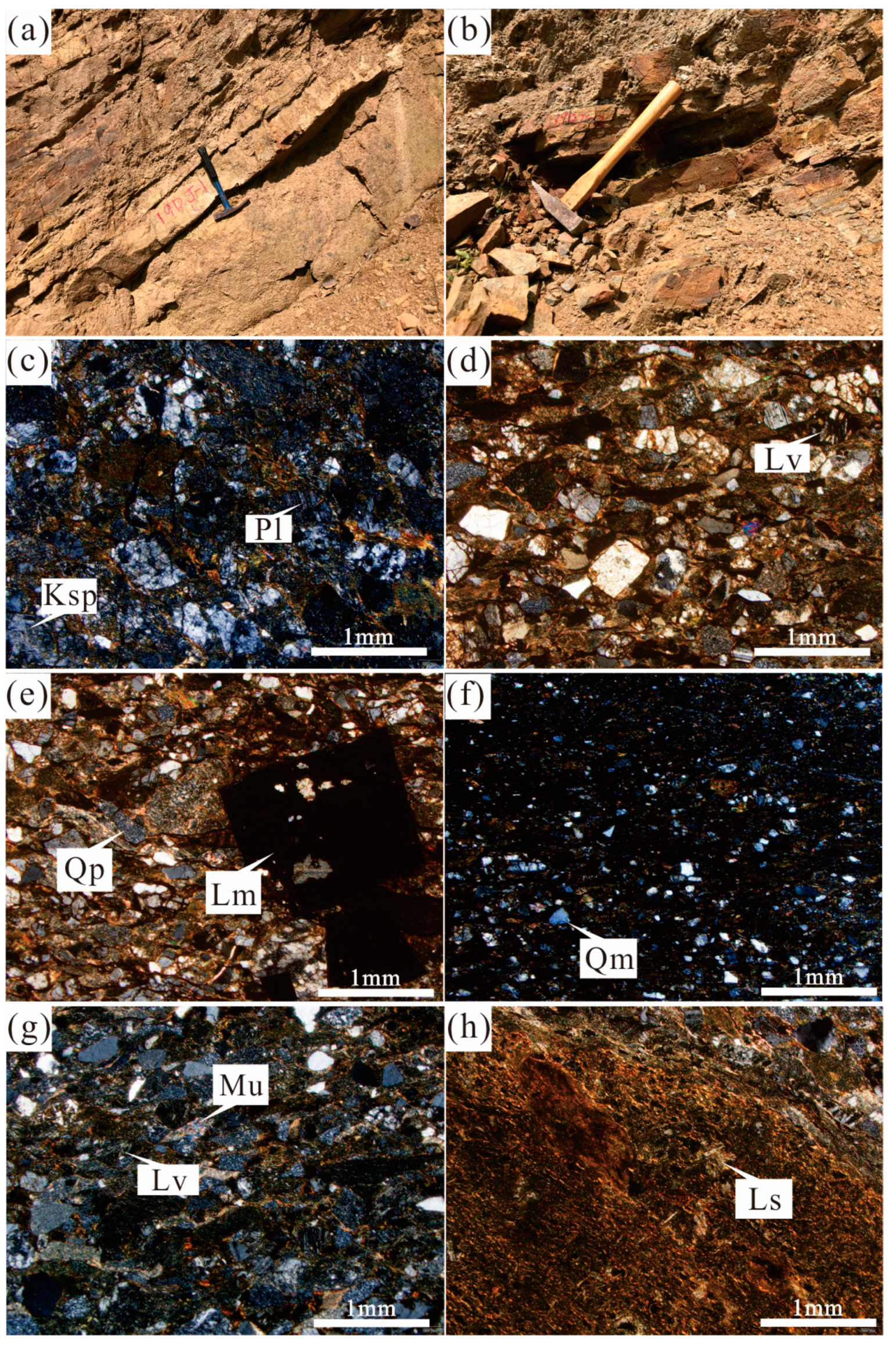
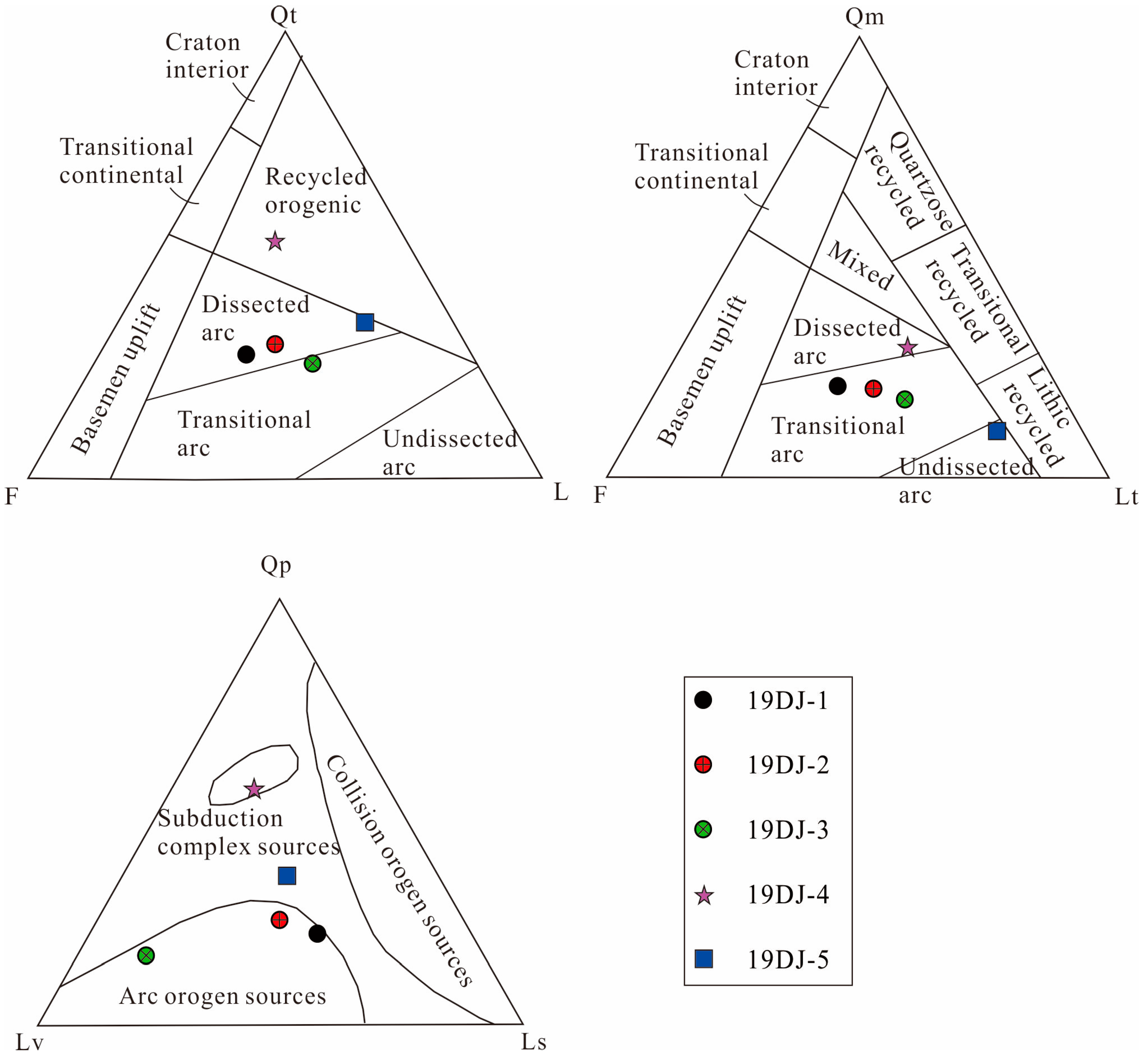
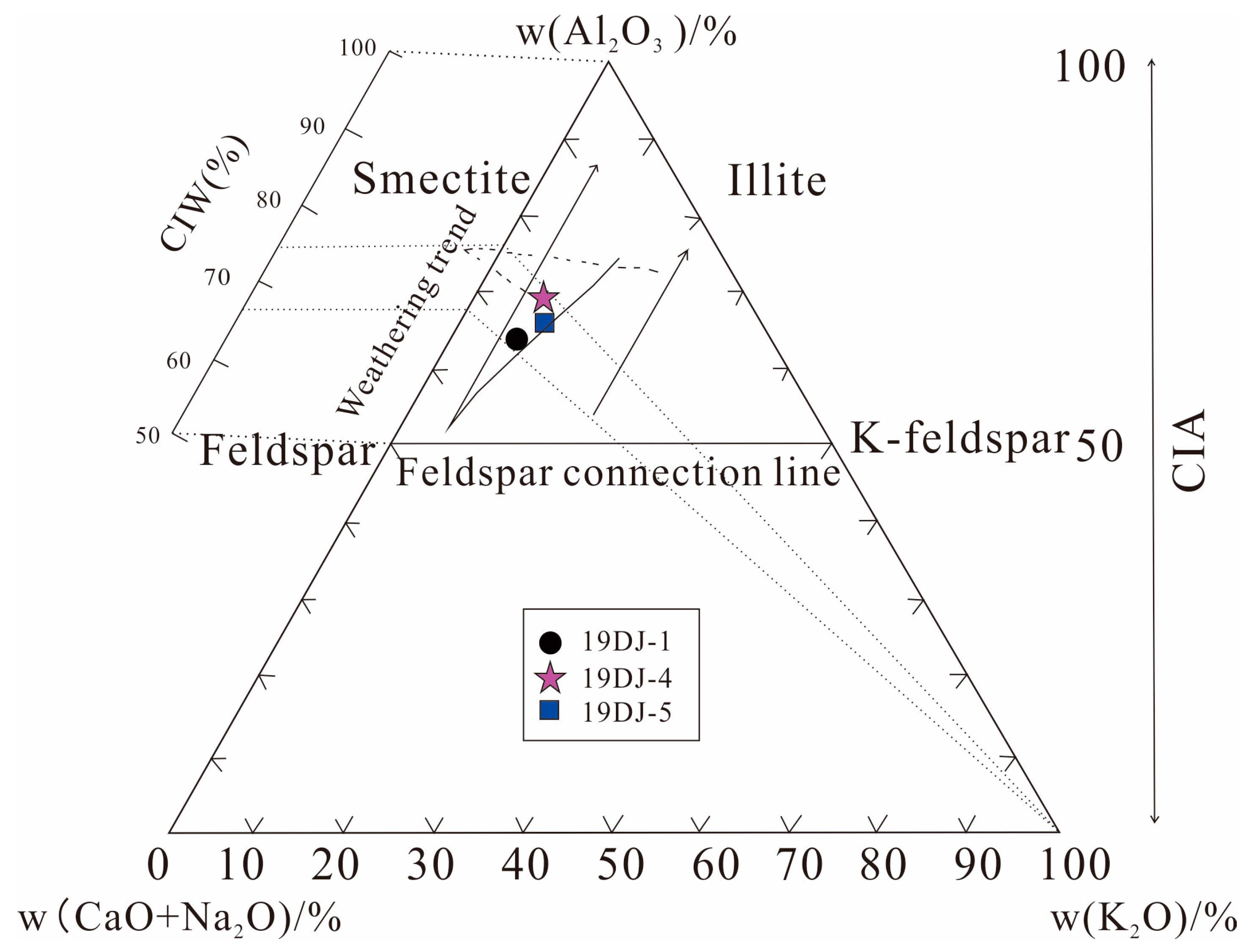
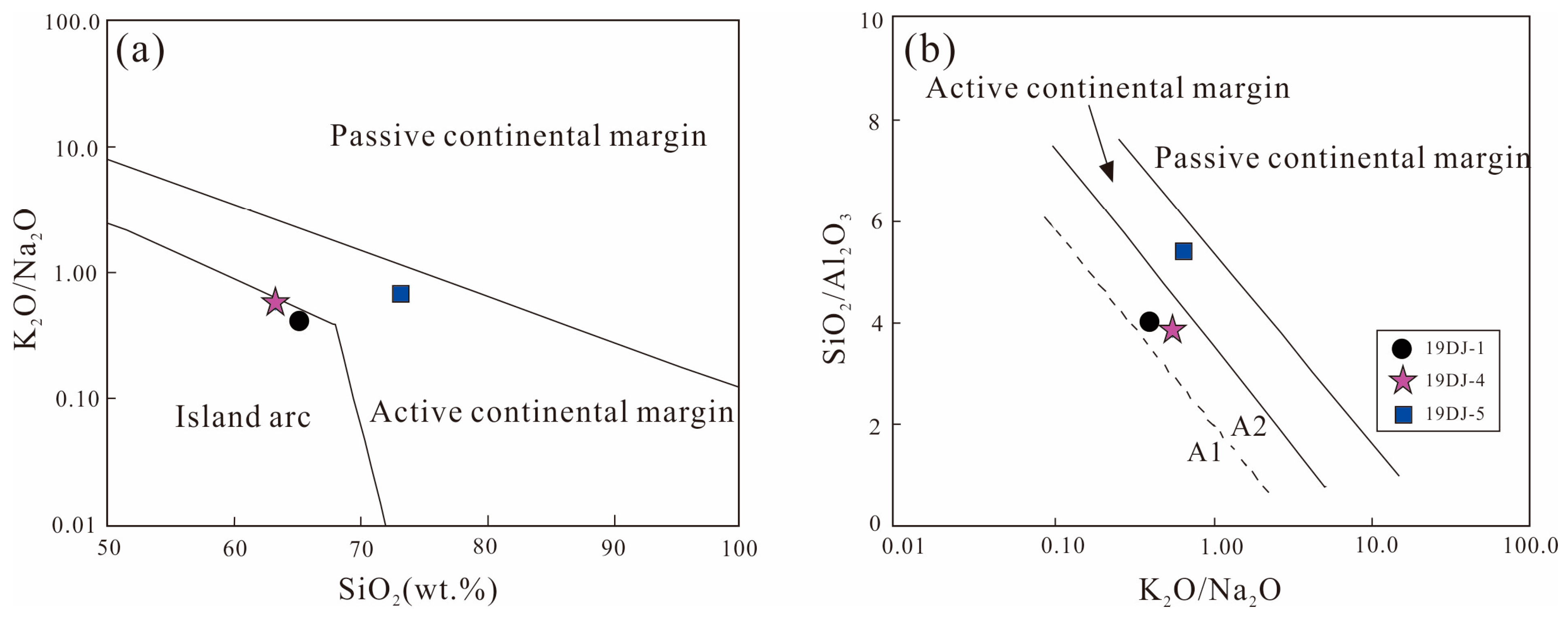


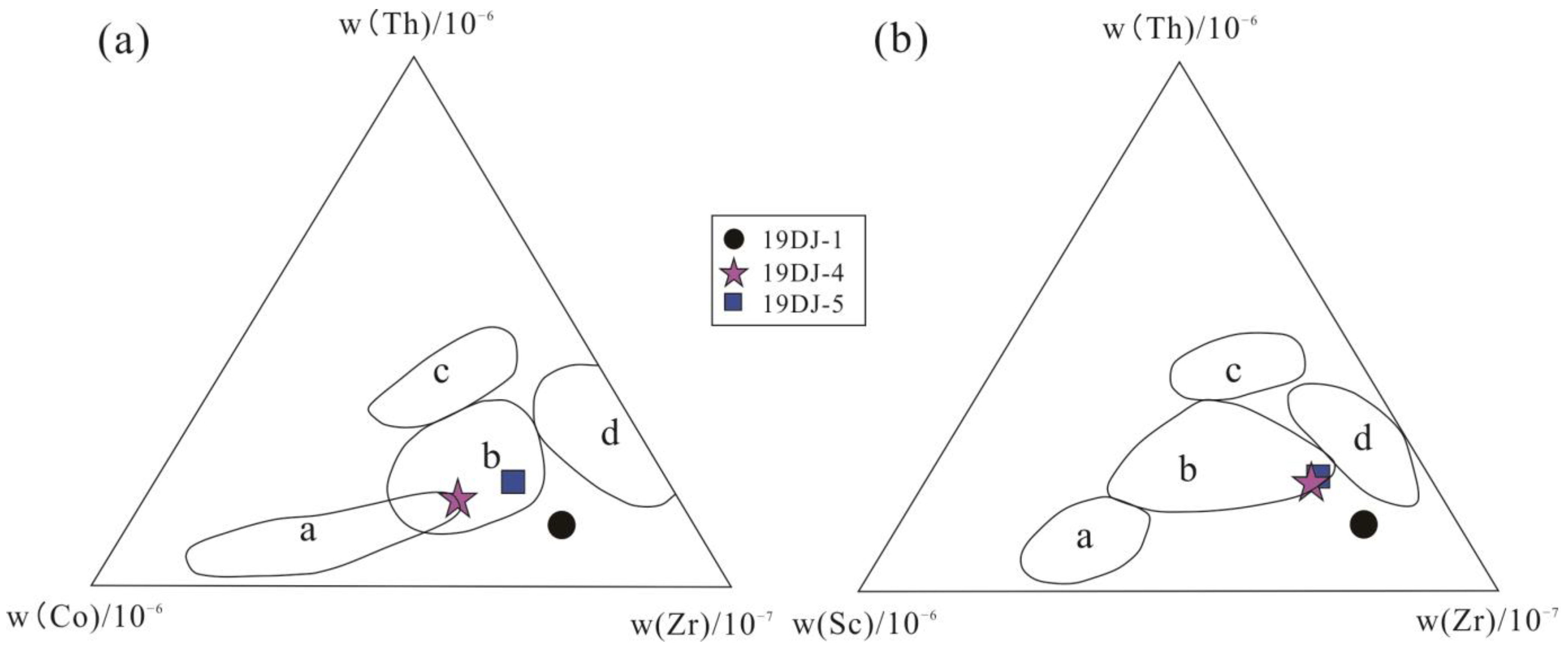
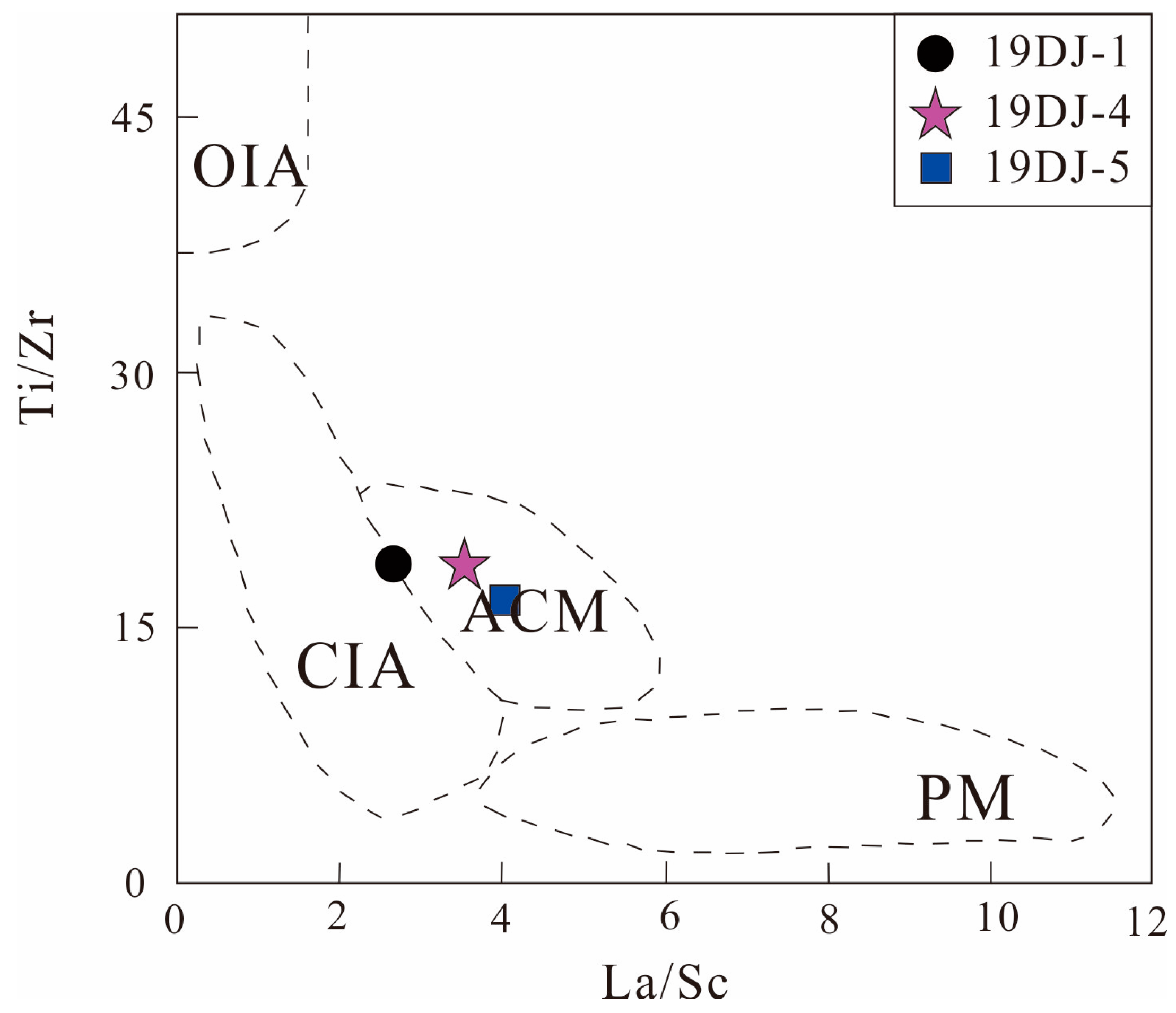
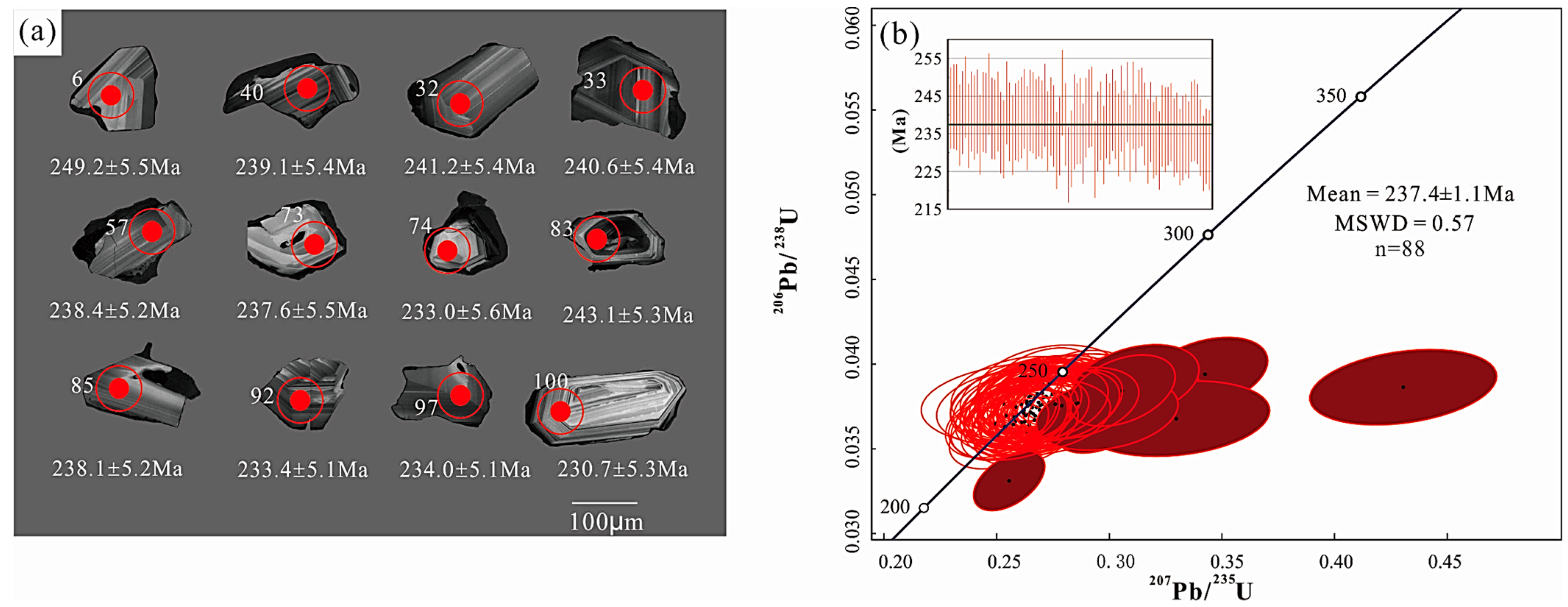
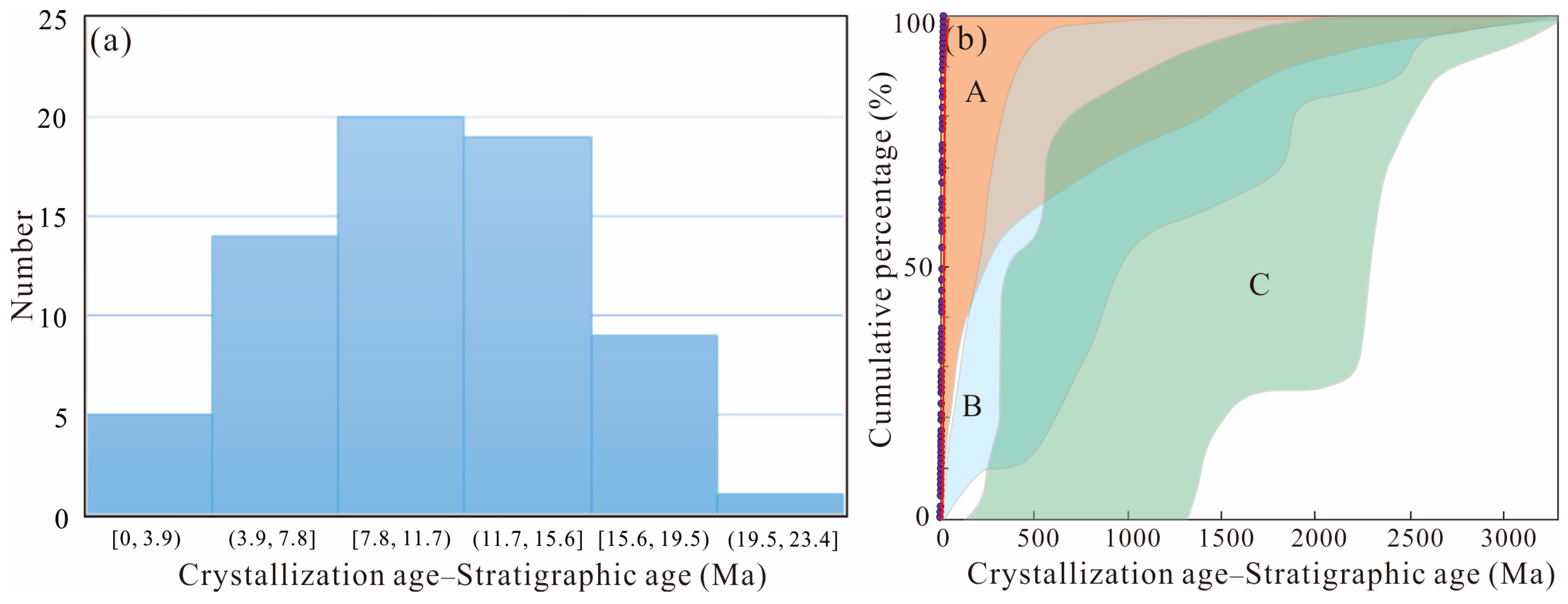
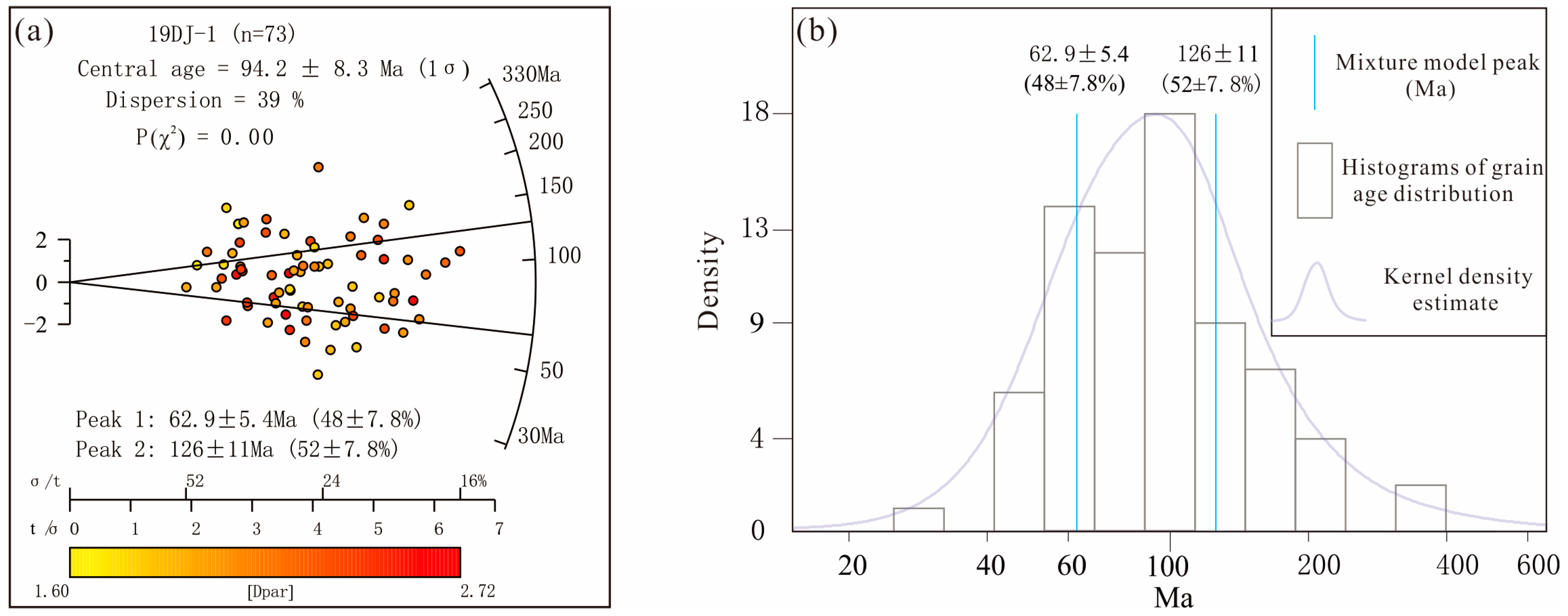
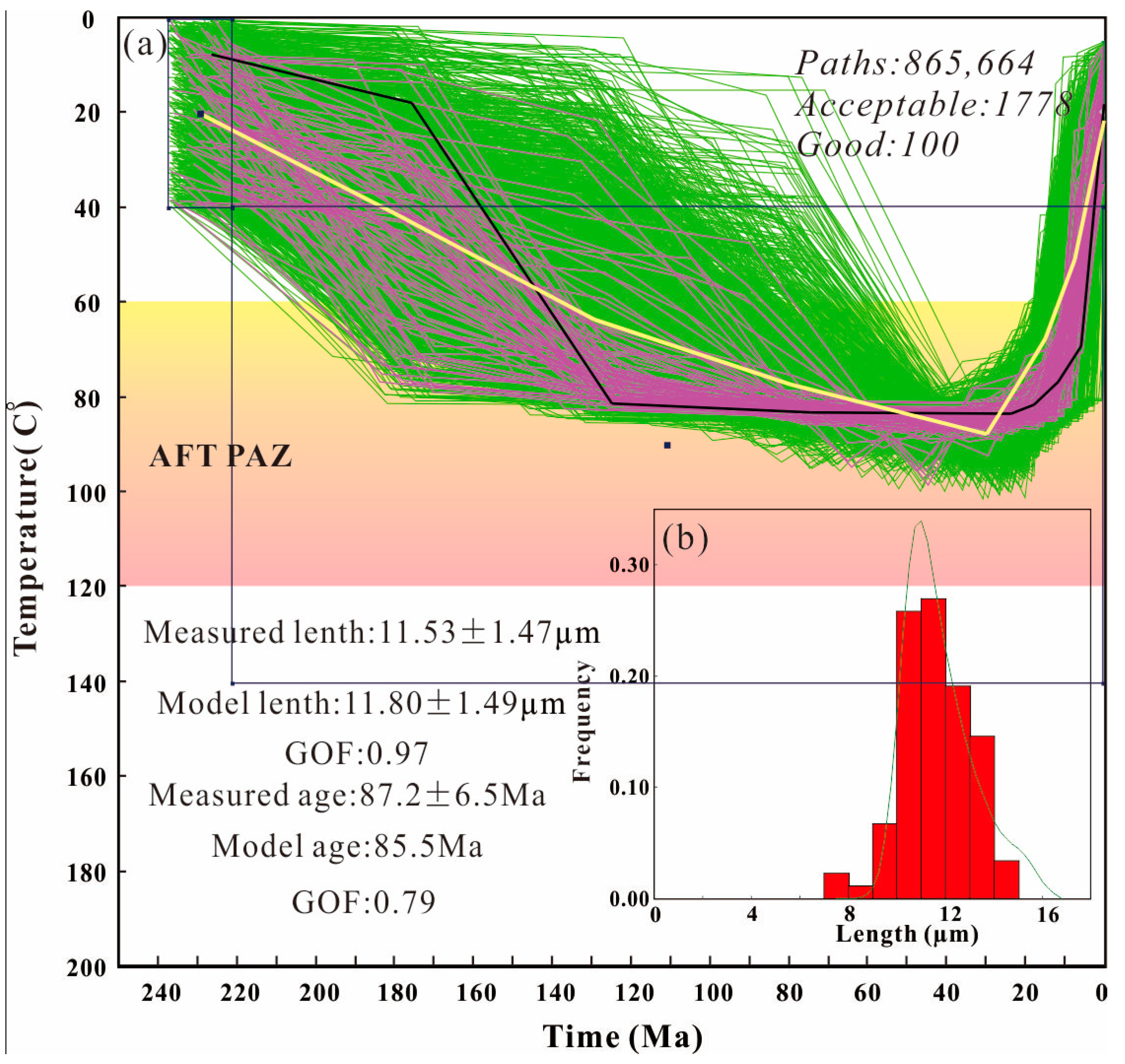
| Group | Sample | Qm | Qp | Pl | Ksp | F | Ls | Lv | Lm | Mu | Bt | M | Total | Qt | L | Lt |
|---|---|---|---|---|---|---|---|---|---|---|---|---|---|---|---|---|
| Dajianggang Formation | 19DJ-1 | 39 | 14 | 70 | 15 | 85 | 33 | 21 | 0 | 0 | 11 | 192 | 395 | 53 | 54 | 68 |
| 19DJ-2 | 54 | 28 | 82 | 20 | 102 | 45 | 44 | 0 | 7 | 0 | 141 | 421 | 82 | 89 | 117 | |
| 19DJ-3 | 23 | 11 | 32 | 11 | 43 | 9 | 47 | 0 | 0 | 0 | 235 | 368 | 34 | 56 | 67 | |
| 19DJ-4 | 65 | 54 | 43 | 15 | 58 | 18 | 29 | 0 | 6 | 0 | 183 | 413 | 119 | 47 | 101 | |
| 19DJ-5 | 11 | 27 | 11 | 8 | 19 | 27 | 25 | 0 | 0 | 0 | 59 | 168 | 38 | 52 | 79 |
| Sample | Lithology | SiO2 | Al2O3 | TFe2O3 | CaO | MgO | K2O | Na2O | TiO2 | P2O5 | MnO | LOI | Total | CIA | CIW | ICV |
|---|---|---|---|---|---|---|---|---|---|---|---|---|---|---|---|---|
| 19DJ-1 | conglomeratic sandstone | 64.98 | 16.6 | 6.23 | 0.63 | 0.96 | 1.71 | 4.3 | 0.89 | 0.26 | 0.07 | 3.19 | 99.82 | 62.23 | 66.88 | 0.89 |
| 19DJ-4 | sandstone | 63.01 | 16.79 | 8.37 | 0.36 | 2.26 | 1.69 | 3.04 | 0.77 | 0.13 | 0.11 | 3.12 | 99.66 | 69.15 | 74.8 | 0.99 |
| 19DJ-5 | greywacke | 72.92 | 13.67 | 3.82 | 0.48 | 0.92 | 1.75 | 2.68 | 0.67 | 0.22 | 0.08 | 2.53 | 99.73 | 65.56 | 72.12 | 0.76 |
| Sample | 19DJ-1 | 19DJ-4 | 19DJ-5 |
|---|---|---|---|
| Lithology | Conglomeratic Sandstone | Sandstone | Greywacke |
| trace elements (×10−6) | |||
| Li | 26.66 | 36.37 | 14.15 |
| Be | 1.74 | 1.79 | 1.75 |
| B | 14.94 | 13.53 | 16.66 |
| Sc | 5.76 | 7.77 | 6.85 |
| V | 104.3 | 104.4 | 77.27 |
| Cr | 74.4 | 227 | 157.9 |
| Co | 8.75 | 17.45 | 10.46 |
| Ni | 53.73 | 105.2 | 62.63 |
| Cu | 20.49 | 22.16 | 19.58 |
| Zn | 83.64 | 113.4 | 60.55 |
| Ga | 19.95 | 21.02 | 18.22 |
| Ge | 6.94 | 9.54 | 7.83 |
| As | 22.85 | 7.63 | 7.42 |
| Se | 1.37 | 1.98 | 1.35 |
| Rb | 17.06 | 25.82 | 43.76 |
| Sr | 142.7 | 185.6 | 126.6 |
| Y | 9.83 | 17.73 | 19.22 |
| Zr | 284.7 | 247.6 | 241.7 |
| Nb | 14.49 | 11.42 | 11.61 |
| Mo | 10.89 | 10.57 | 11.74 |
| Ag | 0.42 | 0.42 | 0.36 |
| Cd | 2.5 | 2.17 | 2.23 |
| Sn | 1.63 | 2.05 | 1.95 |
| Sb | 3.12 | 2.79 | 3.18 |
| Cs | 2.95 | 2.9 | 3.83 |
| Ba | 279.4 | 310.1 | 377.4 |
| La | 15.11 | 27.49 | 27.51 |
| Ce | 30.99 | 58.42 | 46.72 |
| Pr | 4.438 | 7.412 | 6.91 |
| Nd | 16.8 | 27.77 | 25.57 |
| Sm | 3.25 | 5.06 | 4.81 |
| Eu | 0.89 | 1.16 | 1.28 |
| Gd | 2.89 | 4.59 | 4.44 |
| Tb | 0.44 | 0.67 | 0.67 |
| Dy | 2.37 | 3.67 | 3.55 |
| Ho | 0.5 | 0.74 | 0.75 |
| Er | 1.47 | 2.06 | 2.16 |
| Tm | 0.23 | 0.32 | 0.34 |
| Yb | 1.45 | 1.93 | 2.09 |
| Lu | 0.25 | 0.3 | 0.35 |
| Hf | 6.44 | 5.96 | 5.6 |
| Ta | 1.02 | 0.95 | 0.88 |
| W | 1.95 | 2.48 | 2.1 |
| Au | 0.09 | 0.08 | 0.09 |
| Tl | 0.4 | 0.54 | 0.47 |
| Pb | 18.93 | 19.59 | 14.69 |
| Bi | 0.15 | 0.29 | 0.19 |
| Th | 5.06 | 8.44 | 8.69 |
| U | 2.56 | 2.82 | 2.85 |
| ΣREE | 81.07 | 141.58 | 127.14 |
| ΣLREE | 71.48 | 127.3 | 112.8 |
| ΣHREE | 9.6 | 14.28 | 14.34 |
| (La/Yb)N | 0.77 | 1.05 | 0.97 |
| (La/Sm)N | 0.68 | 0.79 | 0.83 |
| (Eu/Yb)N | 1.61 | 1.56 | 1.6 |
| Point Number | Content (×10−6) | Th/U | 207Pb/235U | 206Pb/238U | 207Pb/235U | 206Pb/238U | Concordance (%) | ||||||
|---|---|---|---|---|---|---|---|---|---|---|---|---|---|
| U | Th | Pb | Ratio | 1σ | Ratio | 1σ | Age (Ma) | 1σ | Age (Ma) | 1σ | |||
| 2 * | 564 | 713 | 31 | 1.26 | 0.3146 | 0.0098 | 0.0371 | 0.0008 | 277.8 | 7.6 | 234.9 | 5.2 | 83 |
| 3 | 399 | 421 | 21 | 1.06 | 0.2979 | 0.0103 | 0.0382 | 0.0009 | 264.8 | 8.1 | 241.8 | 5.4 | 91 |
| 4 | 200 | 97 | 9 | 0.49 | 0.2702 | 0.0123 | 0.0383 | 0.0009 | 242.8 | 9.8 | 242.2 | 5.6 | 100 |
| 5 * | 400 | 350 | 21 | 0.88 | 0.3424 | 0.0114 | 0.0394 | 0.0009 | 299 | 8.6 | 249.2 | 5.5 | 82 |
| 6 | 162 | 103 | 8 | 0.64 | 0.2746 | 0.0137 | 0.0383 | 0.0009 | 246.4 | 11 | 242.1 | 5.7 | 98 |
| 7 | 272 | 326 | 15 | 1.2 | 0.2757 | 0.0111 | 0.0375 | 0.0009 | 247.3 | 8.9 | 237.3 | 5.4 | 96 |
| 8 | 240 | 125 | 11 | 0.52 | 0.2706 | 0.0114 | 0.038 | 0.0009 | 243.2 | 9.1 | 240.6 | 5.5 | 99 |
| 9 | 378 | 325 | 20 | 0.86 | 0.2845 | 0.0101 | 0.0387 | 0.0009 | 254.2 | 8 | 244.7 | 5.4 | 96 |
| 10 | 162 | 144 | 8 | 0.89 | 0.255 | 0.013 | 0.0375 | 0.0009 | 230.6 | 10.5 | 237.1 | 5.6 | 97 |
| 11 | 594 | 440 | 29 | 0.74 | 0.2715 | 0.0086 | 0.0381 | 0.0009 | 243.9 | 6.9 | 240.9 | 5.3 | 99 |
| 12 | 174 | 141 | 9 | 0.81 | 0.2798 | 0.0133 | 0.0378 | 0.0009 | 250.5 | 10.5 | 239.3 | 5.6 | 95 |
| 13 | 184 | 114 | 9 | 0.62 | 0.2642 | 0.0125 | 0.0381 | 0.0009 | 238 | 10 | 240.9 | 5.6 | 99 |
| 14 | 301 | 254 | 15 | 0.84 | 0.279 | 0.0108 | 0.0371 | 0.0009 | 249.9 | 8.5 | 234.8 | 5.3 | 94 |
| 15 | 489 | 358 | 24 | 0.73 | 0.2846 | 0.0096 | 0.0381 | 0.0009 | 254.3 | 7.6 | 240.8 | 5.3 | 95 |
| 16 | 526 | 518 | 28 | 0.98 | 0.267 | 0.0087 | 0.038 | 0.0009 | 240.3 | 7 | 240.5 | 5.3 | 100 |
| 17 | 388 | 475 | 22 | 1.23 | 0.2704 | 0.0097 | 0.0388 | 0.0009 | 243 | 7.8 | 245.5 | 5.4 | 99 |
| 18 | 309 | 196 | 15 | 0.63 | 0.2648 | 0.0103 | 0.0378 | 0.0009 | 238.6 | 8.3 | 239.1 | 5.4 | 100 |
| 19 | 469 | 217 | 21 | 0.46 | 0.2655 | 0.009 | 0.0377 | 0.0009 | 239.1 | 7.3 | 238.8 | 5.3 | 100 |
| 20 | 539 | 561 | 29 | 1.04 | 0.2719 | 0.0088 | 0.0381 | 0.0009 | 244.2 | 7.1 | 240.9 | 5.3 | 99 |
| 21 | 232 | 154 | 11 | 0.66 | 0.2761 | 0.0118 | 0.0372 | 0.0009 | 247.6 | 9.4 | 235.3 | 5.4 | 95 |
| 22 | 332 | 280 | 17 | 0.84 | 0.2747 | 0.0104 | 0.0369 | 0.0008 | 246.4 | 8.3 | 233.6 | 5.2 | 95 |
| 23 | 298 | 164 | 14 | 0.55 | 0.2842 | 0.0109 | 0.0385 | 0.0009 | 254 | 8.6 | 243.2 | 5.5 | 96 |
| 25 | 457 | 409 | 23 | 0.89 | 0.2703 | 0.0091 | 0.0376 | 0.0008 | 242.9 | 7.3 | 238.2 | 5.2 | 98 |
| 26 | 319 | 351 | 17 | 1.1 | 0.2719 | 0.0102 | 0.0371 | 0.0008 | 244.2 | 8.1 | 234.7 | 5.3 | 96 |
| 27 | 1000 | 864 | 51 | 0.86 | 0.2608 | 0.0073 | 0.0376 | 0.0008 | 235.3 | 5.9 | 238.2 | 5.1 | 99 |
| 28 | 273 | 149 | 13 | 0.55 | 0.2605 | 0.0105 | 0.0377 | 0.0009 | 235.1 | 8.5 | 238.4 | 5.4 | 99 |
| 29 | 288 | 275 | 15 | 0.96 | 0.2632 | 0.0103 | 0.0378 | 0.0009 | 237.2 | 8.3 | 239.3 | 5.4 | 99 |
| 30 | 667 | 569 | 34 | 0.85 | 0.2785 | 0.0085 | 0.0382 | 0.0009 | 249.4 | 6.7 | 241.6 | 5.3 | 97 |
| 31 | 150 | 116 | 7 | 0.77 | 0.2757 | 0.0141 | 0.0374 | 0.0009 | 247.3 | 11.2 | 236.5 | 5.6 | 96 |
| 32 | 310 | 254 | 16 | 0.82 | 0.2673 | 0.0103 | 0.0381 | 0.0009 | 240.6 | 8.2 | 241.2 | 5.4 | 100 |
| 33 | 314 | 265 | 16 | 0.85 | 0.2669 | 0.0101 | 0.038 | 0.0009 | 240.2 | 8.1 | 240.6 | 5.4 | 100 |
| 34 | 416 | 298 | 20 | 0.72 | 0.2807 | 0.0097 | 0.0378 | 0.0009 | 251.2 | 7.7 | 238.9 | 5.3 | 95 |
| 35 | 394 | 558 | 23 | 1.42 | 0.2806 | 0.0098 | 0.0379 | 0.0009 | 251.2 | 7.8 | 239.6 | 5.3 | 95 |
| 36 | 531 | 488 | 27 | 0.92 | 0.2685 | 0.0087 | 0.0377 | 0.0008 | 241.5 | 7 | 238.8 | 5.2 | 99 |
| 37 | 252 | 196 | 13 | 0.78 | 0.2757 | 0.0113 | 0.0384 | 0.0009 | 247.3 | 9 | 242.6 | 5.5 | 98 |
| 38 | 368 | 328 | 19 | 0.89 | 0.2803 | 0.0102 | 0.0372 | 0.0008 | 250.9 | 8.1 | 235.7 | 5.3 | 94 |
| 39 | 1095 | 960 | 56 | 0.88 | 0.275 | 0.0076 | 0.0379 | 0.0008 | 246.7 | 6 | 239.6 | 5.2 | 97 |
| 40 | 276 | 178 | 13 | 0.65 | 0.2675 | 0.0108 | 0.0375 | 0.0009 | 240.7 | 8.7 | 237.1 | 5.4 | 98 |
| 41 | 366 | 380 | 19 | 1.04 | 0.2527 | 0.0094 | 0.0364 | 0.0008 | 228.8 | 7.6 | 230.6 | 5.1 | 99 |
| 42 | 339 | 217 | 16 | 0.64 | 0.2716 | 0.0102 | 0.037 | 0.0008 | 244 | 8.2 | 234.4 | 5.2 | 96 |
| 43 | 170 | 108 | 8 | 0.63 | 0.2734 | 0.0131 | 0.0389 | 0.0009 | 245.4 | 10.5 | 245.9 | 5.7 | 100 |
| 44 | 198 | 157 | 10 | 0.79 | 0.2637 | 0.0123 | 0.0375 | 0.0009 | 237.6 | 9.9 | 237.5 | 5.5 | 100 |
| 45 | 435 | 444 | 22 | 1.02 | 0.2507 | 0.009 | 0.0358 | 0.0008 | 227.2 | 7.3 | 226.8 | 5 | 100 |
| 46 * | 560 | 262 | 27 | 0.47 | 0.3162 | 0.0097 | 0.0379 | 0.0008 | 279 | 7.5 | 239.9 | 5.3 | 85 |
| 47 | 408 | 537 | 22 | 1.32 | 0.2494 | 0.0091 | 0.0365 | 0.0008 | 226.1 | 7.4 | 231 | 5.1 | 98 |
| 48 | 69 | 47 | 3 | 0.69 | 0.265 | 0.0199 | 0.0376 | 0.001 | 238.7 | 16 | 238.2 | 6.3 | 100 |
| 49 | 254 | 153 | 12 | 0.6 | 0.2787 | 0.0116 | 0.0376 | 0.0009 | 249.6 | 9.2 | 237.7 | 5.4 | 95 |
| 50 | 146 | 102 | 7 | 0.7 | 0.2633 | 0.0139 | 0.0377 | 0.0009 | 237.3 | 11.1 | 238.4 | 5.7 | 100 |
| 51 | 245 | 143 | 11 | 0.58 | 0.2667 | 0.0113 | 0.0367 | 0.0009 | 240 | 9 | 232.4 | 5.3 | 97 |
| 52 | 511 | 557 | 28 | 1.09 | 0.2768 | 0.009 | 0.0378 | 0.0009 | 248.1 | 7.2 | 239.3 | 5.3 | 96 |
| 53 | 757 | 693 | 40 | 0.92 | 0.2746 | 0.0081 | 0.0382 | 0.0008 | 246.3 | 6.5 | 241.7 | 5.2 | 98 |
| 54 | 702 | 1133 | 42 | 1.61 | 0.2783 | 0.0083 | 0.0383 | 0.0009 | 249.3 | 6.6 | 242.2 | 5.3 | 97 |
| 55 | 466 | 352 | 22 | 0.76 | 0.2631 | 0.0095 | 0.036 | 0.0008 | 237.2 | 7.6 | 228.2 | 5.1 | 96 |
| 56 | 291 | 291 | 15 | 1 | 0.2745 | 0.0107 | 0.0372 | 0.0009 | 246.3 | 8.5 | 235.6 | 5.3 | 96 |
| 57 | 652 | 657 | 34 | 1.01 | 0.2763 | 0.0085 | 0.0377 | 0.0008 | 247.7 | 6.8 | 238.4 | 5.2 | 96 |
| 58 | 378 | 406 | 20 | 1.08 | 0.2584 | 0.0095 | 0.0367 | 0.0008 | 233.4 | 7.6 | 232 | 5.2 | 99 |
| 59 | 167 | 139 | 9 | 0.83 | 0.2908 | 0.0138 | 0.0379 | 0.0009 | 259.2 | 10.9 | 239.7 | 5.6 | 92 |
| 60 | 254 | 197 | 13 | 0.77 | 0.2692 | 0.0112 | 0.0376 | 0.0009 | 242.1 | 9 | 237.7 | 5.4 | 98 |
| 61 * | 124 | 102 | 6 | 0.82 | 0.3296 | 0.017 | 0.0368 | 0.0009 | 289.3 | 13 | 232.9 | 5.6 | 78 |
| 62 | 374 | 319 | 19 | 0.85 | 0.265 | 0.0096 | 0.0382 | 0.0009 | 238.7 | 7.7 | 241.3 | 5.4 | 99 |
| 63 | 546 | 448 | 28 | 0.82 | 0.273 | 0.0088 | 0.0377 | 0.0008 | 245.1 | 7 | 238.7 | 5.2 | 97 |
| 64 | 183 | 147 | 9 | 0.8 | 0.266 | 0.0127 | 0.0371 | 0.0009 | 239.5 | 10.2 | 234.7 | 5.5 | 98 |
| 65 | 153 | 101 | 7 | 0.66 | 0.2625 | 0.0134 | 0.0382 | 0.0009 | 236.7 | 10.8 | 241.7 | 5.7 | 98 |
| 66 | 263 | 264 | 14 | 1 | 0.262 | 0.0109 | 0.0373 | 0.0009 | 236.2 | 8.8 | 235.9 | 5.3 | 100 |
| 67 | 582 | 489 | 31 | 0.84 | 0.2978 | 0.0092 | 0.0385 | 0.0009 | 264.7 | 7.2 | 243.4 | 5.3 | 92 |
| 68* | 793 | 749 | 41 | 0.94 | 0.297 | 0.0086 | 0.0367 | 0.0008 | 264 | 6.7 | 232.5 | 5.1 | 87 |
| 69 | 134 | 83 | 7 | 0.62 | 0.284 | 0.0148 | 0.0383 | 0.0009 | 253.9 | 11.7 | 242.5 | 5.8 | 95 |
| 70 | 69 | 23 | 14 | 0.33 | 0.2737 | 0.0087 | 0.0372 | 0.0008 | 245.7 | 6.9 | 235.2 | 5.2 | 96 |
| 71 | 960 | 887 | 51 | 0.92 | 0.2936 | 0.0082 | 0.0382 | 0.0008 | 261.4 | 6.4 | 241.6 | 5.2 | 92 |
| 72 | 838 | 675 | 43 | 0.81 | 0.268 | 0.0078 | 0.0383 | 0.0008 | 241.1 | 6.2 | 242.1 | 5.2 | 100 |
| 73 | 219 | 137 | 11 | 0.63 | 0.2796 | 0.0121 | 0.0376 | 0.0009 | 250.3 | 9.6 | 237.6 | 5.5 | 95 |
| 74 | 144 | 111 | 7 | 0.77 | 0.27 | 0.014 | 0.0368 | 0.0009 | 242.7 | 11.2 | 233 | 5.6 | 96 |
| 75 | 313 | 252 | 16 | 0.8 | 0.2534 | 0.0099 | 0.0376 | 0.0009 | 229.4 | 8 | 238.1 | 5.3 | 96 |
| 76 | 580 | 580 | 30 | 1 | 0.2703 | 0.0085 | 0.0369 | 0.0008 | 243 | 6.8 | 233.3 | 5.1 | 96 |
| 77 * | 301 | 174 | 15 | 0.58 | 0.3115 | 0.0115 | 0.039 | 0.0009 | 275.4 | 8.9 | 246.5 | 5.5 | 89 |
| 78 | 438 | 417 | 22 | 0.95 | 0.2641 | 0.0092 | 0.037 | 0.0008 | 237.9 | 7.4 | 234.5 | 5.2 | 99 |
| 79 | 297 | 242 | 15 | 0.82 | 0.2644 | 0.0104 | 0.0364 | 0.0008 | 238.2 | 8.4 | 230.6 | 5.2 | 97 |
| 80 | 222 | 160 | 11 | 0.72 | 0.2586 | 0.0114 | 0.0375 | 0.0009 | 233.6 | 9.2 | 237.1 | 5.4 | 99 |
| 81 | 158 | 94 | 8 | 0.59 | 0.2689 | 0.0134 | 0.0373 | 0.0009 | 241.8 | 10.7 | 236.1 | 5.6 | 98 |
| 82 * | 206 | 157 | 10 | 0.76 | 0.2989 | 0.0129 | 0.0371 | 0.0009 | 265.6 | 10.1 | 234.5 | 5.4 | 88 |
| 83 * | 528 | 278 | 26 | 0.53 | 0.3056 | 0.0096 | 0.0384 | 0.0009 | 270.8 | 7.5 | 243.1 | 5.3 | 89 |
| 84 | 476 | 431 | 24 | 0.91 | 0.2657 | 0.009 | 0.0375 | 0.0008 | 239.2 | 7.2 | 237 | 5.2 | 99 |
| 85 | 689 | 676 | 36 | 0.98 | 0.2848 | 0.0085 | 0.0376 | 0.0008 | 254.5 | 6.8 | 238.1 | 5.2 | 93 |
| 86 | 409 | 445 | 22 | 1.09 | 0.2539 | 0.0092 | 0.037 | 0.0008 | 229.8 | 7.4 | 234 | 5.2 | 98 |
| 87 | 285 | 334 | 16 | 1.17 | 0.2649 | 0.0106 | 0.0372 | 0.0009 | 238.6 | 8.5 | 235.3 | 5.3 | 99 |
| 88 | 460 | 408 | 23 | 0.89 | 0.2609 | 0.009 | 0.0366 | 0.0008 | 235.4 | 7.2 | 231.5 | 5.1 | 98 |
| 89 | 147 | 99 | 7 | 0.67 | 0.267 | 0.0137 | 0.037 | 0.0009 | 240.3 | 10.9 | 233.9 | 5.6 | 97 |
| 90 | 341 | 368 | 18 | 1.08 | 0.2617 | 0.0099 | 0.0371 | 0.0009 | 236.1 | 8 | 235 | 5.3 | 100 |
| 91 * | 2011 | 2044 | 96 | 1.02 | 0.2554 | 0.0065 | 0.0331 | 0.0007 | 231 | 5.2 | 210 | 4.5 | 90 |
| 92 | 613 | 531 | 31 | 0.87 | 0.2576 | 0.0082 | 0.0369 | 0.0008 | 232.8 | 6.6 | 233.4 | 5.1 | 100 |
| 93 | 429 | 239 | 20 | 0.56 | 0.2759 | 0.0096 | 0.0376 | 0.0009 | 247.4 | 7.6 | 238.2 | 5.3 | 96 |
| 94 | 296 | 220 | 15 | 0.74 | 0.2859 | 0.0111 | 0.0377 | 0.0009 | 255.4 | 8.7 | 238.6 | 5.4 | 93 |
| 95 | 330 | 222 | 16 | 0.67 | 0.2788 | 0.0105 | 0.0376 | 0.0009 | 249.7 | 8.3 | 237.6 | 5.3 | 95 |
| 97 | 611 | 500 | 30 | 0.82 | 0.2628 | 0.0083 | 0.037 | 0.0008 | 236.9 | 6.7 | 234 | 5.1 | 99 |
| 98 | 666 | 576 | 33 | 0.87 | 0.2535 | 0.0079 | 0.0363 | 0.0008 | 229.4 | 6.4 | 229.8 | 5 | 100 |
| 99 | 786 | 758 | 40 | 0.96 | 0.2622 | 0.0079 | 0.0366 | 0.0008 | 236.5 | 6.3 | 231.7 | 5 | 98 |
| 100 | 211 | 101 | 10 | 0.48 | 0.2573 | 0.0117 | 0.0364 | 0.0009 | 232.4 | 9.5 | 230.7 | 5.3 | 99 |
| Sample | Longitude (°E) | Latitude (°N) | Elevation (m) | Lithology/ Strata | Nc | ρs | ρi | ρd | U | P(χ2) | Central Age | Dpar (μm) | MTL | N |
|---|---|---|---|---|---|---|---|---|---|---|---|---|---|---|
| (105/cm2) | (105/cm2) | (105/cm2) | (×10−6) | (Ma) | (μm) | |||||||||
| (Ns) | (Ni) | (Nd) | /% | 1σ | 1σ | |||||||||
| 19DJ-1 | 125°49′25″ | 43°22′53″ | 309 | pebbly sandstone/T3d | 73 | 7.922 (1777) | 19.759 | 17 | 15.77 | 0 | 94.2 ± 8.3 | 2.15 | 11.53 ± 1.47 | 89 |
| (4432) | (15,655) |
Disclaimer/Publisher’s Note: The statements, opinions and data contained in all publications are solely those of the individual author(s) and contributor(s) and not of MDPI and/or the editor(s). MDPI and/or the editor(s) disclaim responsibility for any injury to people or property resulting from any ideas, methods, instructions or products referred to in the content. |
© 2023 by the authors. Licensee MDPI, Basel, Switzerland. This article is an open access article distributed under the terms and conditions of the Creative Commons Attribution (CC BY) license (https://creativecommons.org/licenses/by/4.0/).
Share and Cite
Tang, S.; Li, S.; Zhang, X.; Zhang, D.; Wang, H.; Nie, L.; Zhou, X.; Li, M. Late Triassic Tectonic Setting in Northeastern Margin of North China Craton: Insight into Sedimentary and Apatite Fission Tracks. Minerals 2023, 13, 975. https://doi.org/10.3390/min13070975
Tang S, Li S, Zhang X, Zhang D, Wang H, Nie L, Zhou X, Li M. Late Triassic Tectonic Setting in Northeastern Margin of North China Craton: Insight into Sedimentary and Apatite Fission Tracks. Minerals. 2023; 13(7):975. https://doi.org/10.3390/min13070975
Chicago/Turabian StyleTang, Shuang, Shichao Li, Xinmei Zhang, Daixin Zhang, Hongtao Wang, Lijun Nie, Xiaodong Zhou, and Mengqi Li. 2023. "Late Triassic Tectonic Setting in Northeastern Margin of North China Craton: Insight into Sedimentary and Apatite Fission Tracks" Minerals 13, no. 7: 975. https://doi.org/10.3390/min13070975
APA StyleTang, S., Li, S., Zhang, X., Zhang, D., Wang, H., Nie, L., Zhou, X., & Li, M. (2023). Late Triassic Tectonic Setting in Northeastern Margin of North China Craton: Insight into Sedimentary and Apatite Fission Tracks. Minerals, 13(7), 975. https://doi.org/10.3390/min13070975








